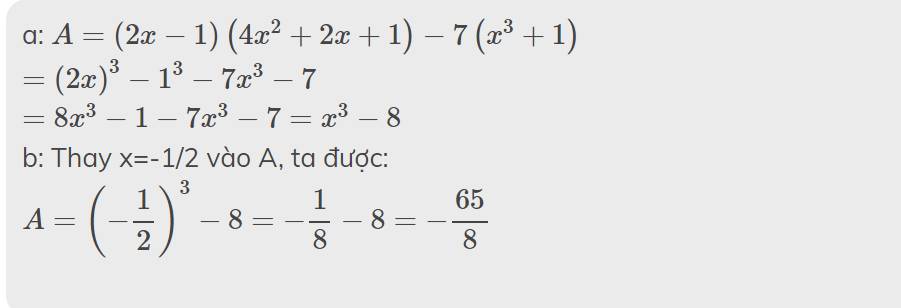cho biểu thức\(A=\frac{7-x}{2x-1}\).Tìm các giá trị của x để A là số nguyên
Hãy nhập câu hỏi của bạn vào đây, nếu là tài khoản VIP, bạn sẽ được ưu tiên trả lời.


a: \(A=\left(2x-1\right)\left(4x^2+2x+1\right)-7\left(x^3+1\right)\)
\(=\left(2x\right)^3-1^3-7x^3-7\)
\(=8x^3-1-7x^3-7=x^3-8\)
b: Thay x=-1/2 vào A, ta được:
\(A=\left(-\dfrac{1}{2}\right)^3-8=-\dfrac{1}{8}-8=-\dfrac{65}{8}\)


c: \(A=x^3-8=\left(x-2\right)\left(x^2+2x+4\right)\)
Để A là số nguyên tố thì x-2=1
=>x=3

A = \(\dfrac{2x-1}{x+2}\)
a, A là phân số ⇔ \(x\) + 2 # 0 ⇒ \(x\) # -2
b, Để A là một số nguyên thì 2\(x-1\) ⋮ \(x\) + 2
⇒ 2\(x\) + 4 - 5 ⋮ \(x\) + 2
⇒ 2(\(x\) + 2) - 5 ⋮ \(x\) + 2
⇒ 5 ⋮ \(x\) + 2
⇒ \(x\) + 2 \(\in\) { -5; -1; 1; 5}
⇒ \(x\) \(\in\) { -7; -3; -1; 3}
c, A = \(\dfrac{2x-1}{x+2}\)
A = 2 - \(\dfrac{5}{x+2}\)
Với \(x\) \(\in\) Z và \(x\) < -3 ta có
\(x\) + 2 < - 3 + 2 = -1
⇒ \(\dfrac{5}{x+2}\) > \(\dfrac{5}{-1}\) = -5 ⇒ - \(\dfrac{5}{x+2}\)< 5
⇒ 2 - \(\dfrac{5}{x+2}\) < 2 + 5 = 7 ⇒ A < 7 (1)
Với \(x\) > -3; \(x\) # - 2; \(x\in\) Z ⇒ \(x\) ≥ -1 ⇒ \(x\) + 2 ≥ -1 + 2 = 1
\(\dfrac{5}{x+2}\) > 0 ⇒ - \(\dfrac{5}{x+2}\) < 0 ⇒ 2 - \(\dfrac{5}{x+2}\) < 2 (2)
Với \(x=-3\) ⇒ A = 2 - \(\dfrac{5}{-3+2}\) = 7 (3)
Kết hợp (1); (2) và(3) ta có A(max) = 7 ⇔ \(x\) = -3

1) a) Căn thức có nghĩa \(\Leftrightarrow4-2x\ge0\Leftrightarrow2x\le4\Leftrightarrow x\le2\)
b) Thay x = 2 vào biểu thức A, ta được: \(A=\sqrt{4-2.2}=\sqrt{0}=0\)
Thay x = 0 vào biểu thức A, ta được: \(A=\sqrt{4-2.0}=\sqrt{4}=2\)
Thay x = 1 vào biểu thức A, ta được: \(A=\sqrt{4-2.1}=\sqrt{2}\)
Thay x = -6 vào biểu thức A, ta được: \(A=\sqrt{4-2.\left(-6\right)}=\sqrt{16}=4\)
Thay x = -10 vào biểu thức A, ta được: \(A=\sqrt{4-2.\left(-10\right)}=\sqrt{24}=2\sqrt{6}\)
c) \(A=0\Leftrightarrow\sqrt{4-2x}=0\Leftrightarrow4-2x=0\Leftrightarrow x=2\)
\(A=5\Leftrightarrow\sqrt{4-2x}=5\Leftrightarrow4-2x=25\Leftrightarrow x=\frac{-21}{2}\)
\(A=10\Leftrightarrow\sqrt{4-2x}=10\Leftrightarrow4-2x=100\Leftrightarrow x=-48\)

a) \(Q=\frac{x+3}{2x+1}-\frac{x-7}{2x+1}\left(ĐK:x\ne-\frac{1}{2}\right)\)
\(=\frac{x+3-x+7}{2x+1}=\frac{10}{2x+1}\)
b) Để Q nguyên \(\Leftrightarrow\frac{10}{2x+1}\in Z\)
=> \(2x+1\inƯ\left(10\right)\)
=> \(2x+1\in\left\{1;-1;2;-2;5;-5;10;-10\right\}\)
Ta có bảng sau:
| 2x+1 | 1 | -1 | 2 | -2 | 4 | -4 | 10 | -10 |
| x | 0 | -1 | \(\frac{1}{2}\) (loại) | \(-\frac{3}{2}\)(loại) | \(\frac{3}{2}\)(loại) | \(-\frac{5}{2}\)(loại) | \(\frac{9}{2}\)(loại) | \(-\frac{11}{2}\)(loại) |
Vậy \(x\in\left\{0;-1\right\}\)

a) \(A=\left(\frac{1}{1-x}+\frac{2}{x+1}-\frac{5-x}{1-x^2}\right):\frac{1-2x}{x^2-1}\) (ĐKXĐ: \(x\ne\pm1\) )
\(=\left(\frac{x+1+2\left(1-x\right)-5+x}{1-x^2}\right):\frac{1-2x}{x^2-1}\)
\(=\left(\frac{x+1+2-2x-5+x}{1-x^2}\right):\frac{1-2x}{x^2-1}\)
\(=\left(\frac{-2}{1-x^2}\right):\frac{1-2x}{x^2-1}\)
\(=\frac{2}{x^2-1}.\frac{x^2-1}{1-2x}=\frac{2}{1-2x}\)
b) Để x nhận giá trị nguyên <=> 2 chia hết cho 1 - 2x
<=> 1-2x thuộc Ư(2) = {1;2;-1;-2}
Nếu 1-2x = 1 thì 2x = 0 => x= 0
Nếu 1-2x = 2 thì 2x = -1 => x = -1/2
Nếu 1-2x = -1 thì 2x = 2 => x =1
Nếu 1-2x = -2 thì 2x = 3 => x = 3/2
Vậy ....

a, ĐKXĐ: x\(\ne\) 1;-1;2
b, A= \(\left(\frac{x}{x+1}+\frac{1}{x-1}-\frac{4x}{2-2x^2}\right):\frac{x+1}{x-2}\)
=\(\left(\frac{2x^2-2x}{2\left(x+1\right)\left(x-1\right)}+\frac{2x+2}{2\left(x+1\right)\left(x-1\right)}+\frac{4x}{2\left(x-1\right)\left(x+1\right)}\right)\times\frac{x-2}{x+1}\)
=\(\frac{2x^2-2x+2x+2+4x}{2\left(x+1\right)\left(x-1\right)}\times\frac{x-2}{x+1}\)
=\(\frac{2x^2+4x+2}{2\left(x+1\right)\left(x-1\right)}\times\frac{x-2}{x+1}\)
=\(\frac{2\left(x+1\right)^2}{2\left(x+1\right)\left(x-1\right)}\times\frac{x-2}{x+1}\)
=\(\frac{x-2}{x-1}\)
c, Khi x= -1
→A= \(\frac{-1-2}{-1-1}\)
= -3
Vậy khi x= -1 thì A= -3
Câu d thì mình đang suy nghĩ nhé, mình sẽ quay lại trả lời sau ^^
a,ĐKXĐ:x#1; x#-1; x#2
b,Ta có:
A=\(\left(\frac{x}{x+1}+\frac{1}{x-1}-\frac{4x}{2-2x^2}\right):\frac{x+1}{x-2}\)
=\(\left(\frac{x\left(x-1\right)2}{\left(x+1\right)\left(x-1\right)2}+\frac{\left(x+1\right)2}{\left(x-1\right)\left(x+1\right)2}+\frac{4x}{2\left(x-1\right)\left(x+1\right)}\right):\frac{x+1}{x-2}\)
=\(\frac{2x^2-2x+2x+2+4x}{\left(x+1\right)\left(x-1\right)2}.\frac{x-2}{x+1}\)
=\(\frac{2x^2+4x+2}{\left(x+1\right)\left(x-1\right)2}.\frac{x-2}{x+1}\)
=\(\frac{2\left(x+1\right)^2}{\left(x+1\right)\left(x-1\right)2}.\frac{x-2}{x+1}\)
=\(\frac{x-2}{x+1}\)
c,Tại x=-1 ,theo ĐKXĐ x#-1 \(\Rightarrow\)A không có kết quả
d,Để A có giá trị nguyên \(\Rightarrow\frac{x-2}{x+1}\)có giá trị nguyên
\(\Leftrightarrow x-2⋮x+1\)
\(\Leftrightarrow x+1-3⋮x+1\)
Mà \(x+1⋮x+1\Rightarrow3⋮x+1\)
\(\Rightarrow x+1\inƯ\left(3\right)=\left\{1;-1;3;-3\right\}\)
\(\Rightarrow x\in\left\{0;-2;2;-4\right\}\)
Mà theo ĐKXĐ x#2\(\Rightarrow x\in\left\{0;-2;-4\right\}\)
Vậy \(x\in\left\{0;-2;-4\right\}\)thì a là số nguyên

Để A đạt GTLN thì \(\frac{3}{4-x}\)phải đạt giá trị lớn nhất\(\Rightarrow\)4-x phải bé nhất và 4-x>0
\(\Rightarrow4-x=1\rightarrow x=3\)
thay vào ta đc A=3
B3
\(B=\frac{7-x}{4-x}=\frac{4-x+3}{4-x}=\frac{4-x}{4-x}+\frac{3}{4-x}\)\(=1+\frac{3}{4-x}\)
Để b đạt GTLn thì 3/4-x phải lớn nhất (làm tương tụ như bài 2 )
Vậy gtln của 3/4-x là 3 thay vào ta đc b=4
Lâm như bài 2 Gtln của\(\frac{3}{4-x}\)
B1\(\frac{4x-3}{2x+1}=\frac{4x+2-5}{2x+1}=\frac{2.\left(2x+1\right)-5}{2x+1}\)\(=\frac{2.\left(2x+1\right)}{2x+1}-\frac{5}{2x+1}=2-\frac{5}{2x+1}\)
VÌ A\(\varepsilon Z\),2\(\varepsilon Z\)\(\Rightarrow\)\(\frac{5}{2x+1}\varepsilon Z\)\(\rightarrow2x+1\varepsilonƯ\left(5\right)\)={1;-1;5;-5}
\(\Rightarrow\)x={0;-1;23}

\(ĐKXĐ:x\ne\pm1\)
a) \(A=\left(\frac{1}{1-x}+\frac{2}{1+x}-\frac{5-x}{1-x^2}\right):\frac{1-2x}{x^2-1}\)
\(=\left(\frac{\left(1+x\right)}{\left(1+x\right)\left(1-x\right)}+\frac{2\left(1-x\right)}{\left(1+x\right)\left(1-x\right)}-\frac{5-x}{1-x^2}\right):\frac{1-2x}{x^2-1}\)
\(=\frac{1+x+2-2x-5+x}{1-x^2}:\frac{2x-1}{1-x^2}\)
\(=\frac{8}{1-x^2}.\frac{1-x^2}{2x-1}=\frac{8}{2x-1}\)
b) Để A nguyên thì \(\frac{8}{2x-1}\inℤ\)
\(\Leftrightarrow8⋮2x-1\Rightarrow2x-1\inƯ\left(8\right)=\left\{\pm1;\pm2;\pm4;\pm8\right\}\)
Mà dễ thấy 2x - 1 lẻ nên\(2x-1\in\left\{\pm1\right\}\)
+) \(2x-1=1\Rightarrow x=1\left(ktmđkxđ\right)\)
+) \(2x-1=-1\Rightarrow x=0\left(tmđkxđ\right)\)
Vậy x nguyên bằng 0 thì A nguyên
c) \(\left|A\right|=A\Leftrightarrow A\ge0\)
\(\Rightarrow\frac{8}{2x-1}\ge0\Rightarrow2x-1>0\Leftrightarrow x>\frac{1}{2}\)
Vậy \(x>\frac{1}{2}\)thì |A| = A
a, \(A=\left(\frac{1}{1-x}+\frac{2}{1+x}-\frac{5-x}{1-x^2}\right):\frac{1-2x}{x^2-1}\left(x\ne\frac{1}{2};x\ne\pm1\right)\)
\(\Leftrightarrow A=\left(\frac{1+x}{\left(1-x\right)\left(1+x\right)}+\frac{2-2x}{\left(1-x\right)\left(1+x\right)}-\frac{5-x}{\left(1-x\right)\left(1+x\right)}\right):\frac{\left(x+1\right)\left(x-1\right)}{2x-1}\)
\(\Leftrightarrow A=\frac{1+x+2-2x-5+x}{\left(1-x\right)\left(1+x\right)}\cdot\frac{\left(x-1\right)\left(x+1\right)}{2x-1}\)
\(\Leftrightarrow A=\frac{-2\left(1-x^2\right)}{\left(1-x^2\right)\left(2x-1\right)}=\frac{2}{2x-1}\)
Vậy \(A=\frac{2}{2x-1}\left(x\ne\frac{1}{2};x\ne\pm1\right)\)
b) \(A=\frac{2}{2x-1}\left(x\ne\frac{1}{2};x\ne\pm1\right)\)
Để A nhận giá trị nguyên thì 2 chia hết cho 2x-1
Mà x nguyên => 2x-1 nguyên
=> 2x-1 thuộc Ư (2)={-2;-1;1;2}
Ta có bảng
| 2x-1 | -2 | -1 | 1 | 2 |
| 2x | -1 | 0 | 2 | 3 |
| x | -1/2 | 0 | 1 | 3/2 |
Đối chiếu điều kiện
=> x=0
Ta có : \(A=\frac{7-x}{2x-1}\)
=> \(2A=\frac{14-2x}{2x-1}=\frac{1-2x+13}{2x-1}=\frac{-\left(2x-1\right)+13}{2x-1}=-1+\frac{13}{2x-1}\)
Để 2A \(\inℤ\)
=> 13 \(⋮\)2x - 1
=> 2x - 1 \(\inƯ\left(13\right)\)
=> 2x - 1 \(\in\left\{1;-13;-1;13\right\}\)
=> \(2x\in\left\{2;-12;0;14\right\}\)
=> \(x\in\left\{1;-6;0;7\right\}\)
Thay x = 1 vào A => A = 6 (TM)
Thay x = -6 vào A => A = -1 (TM)
Thay x = 0 vào A => A = -7
Thay x = 7 vào A => A = 0
Vậy \(x\in\left\{1;-6;0;7\right\}\)thì A nguyên